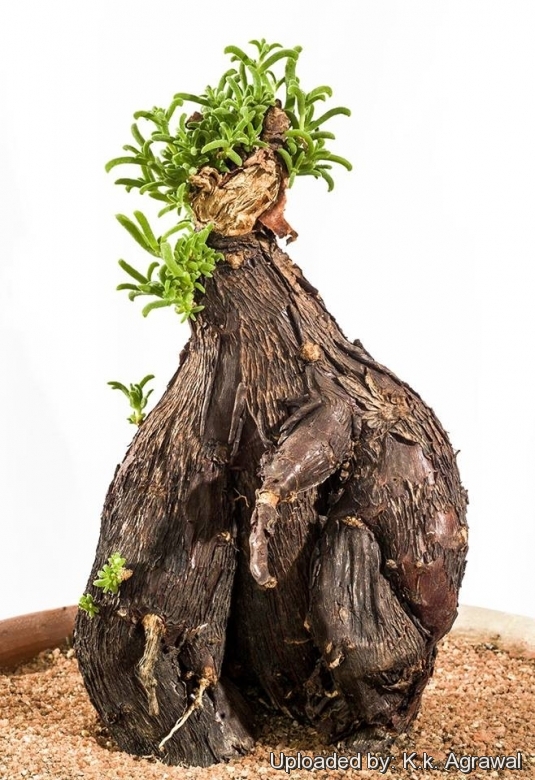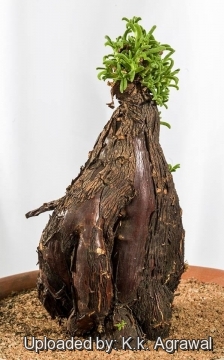Accepted Scientific Name: Mestoklema tuberosum (L.) N.E.Br. ex Glen
Bothalia 13(3?4): 454 (1981)

Mesembryanthemum tuberosum (Mestoklema tuberosum) Photo by: K.k. Agrawal
Origin and Habitat: South Namibia to Little Karoo and Eastern Cape in South Africa.
Habitat: Mestoklema tuberosumSN|28000]]SN|28000]] forms dense scrubs in alluvial soils.
Synonyms:
See all synonyms of Mestoklema tuberosum
back
Accepted name in llifle Database:Mestoklema tuberosum (L.) N.E.Br. ex GlenBothalia 13(3?4): 454 (1981)Synonymy: 6
back
Common Names include:
ENGLISH: Donkey Mesemb, Donkey Fig
AFRIKAANS (Afrikaans): Donkievygif, Donkiebossie, Donkiebos, Donkievy
Description: Mestoklema tuberosumSN|875]]SN|28000]] is a perennial bushy much branched shrub, 30-60(-70) cm tall, with characteristic potato-shaped roots often erroneously referred in cultivation as a “caudex”. It is drought resistant, spineless and has numerous small orange flower and is usually encountered as a potted specimen with the upper portion of its attractive swollen roots on display. Not a wonderful garden plant, but a very good container plant priced by aficionados of bonsai.
Roots system: Tuberous consisting of branched, subglobose, dahlia-like, twisted food storing roots with a reddish-brown, peeling bark, and wonderfully thick. In habitat the fat rootstock grows buried in the ground, but in cultivation, once the tuberous roots develop, the plant is lifted above soil level and replanted with roots exposed making a very showy bonsai-like specimen.
Branches: Lax, twiggy, wiry, dried out looking twisting and decumbent, brown with age.
Leaves: Spreading, finger-like, slender, rounded-triangular in cross-section, recurved at tips, finely papillate with a minutely bumpy texture like that of a tongue, (9-)10-15(-20) mm long,1.1-2.2 mm in diameter.
Flowers: Daisy-like, very small, 4-6(-15?) mm in diameter. In short branching terminal cymes, generally in the reddish-orange-yellow range, but also salmon-orange, cream or violet. After the flowers have passed, the old inflorescence branches persist as a light grey zig-zag meshwork among the leaves.
Blooming season: This species has a long flowering period extending through the summer months into the autumn (In habitat from February to June)
Fruits: 5-locular, without closing bodies, c. 3.5 mm in diameter.
Remarks: There are contrasting opinions on whether the plants commonly found in culture are Mestoklema tuberosumSN|28000]]SN|28000]] or Mestoklema arboriformeSN|28000]]SN|875]]. The one and the other have dull white, yellow or orange flowers and the description of these two taxa in Jacobsen is obscure enough that it could be either.
Bibliography: Major references and further lectures
1) Urs Eggli “Illustrated Handbook of Succulent Plants: Dicotyledons” Springer Science & Business Media, 2002
2) H. E. K. Hartmann “Illustrated Handbook of Succulent Plants: Aizoaceae F-Z” Springer, 2002
3) Hermann Jacobsen “A handbook of succulent plants: descriptions, synonyms, and cultural details for succulents other than Cactaceae” Blandford Press, 1960
4) Doreen Court “Succulent Flora of Southern Africa” CRC Press, 01/Jun/2000
5) Botanical Survey of South Africa, South Africa. Dept. of Agriculture and Forestry, South Africa. Dept. of Agriculture and Forestry. Division of Plant Industry, South Africa. Dept. of Agriculture. Division of Botany and Plant Pathology, Botanical Research Institute (South Africa), South Africa. Dept. of Agriculture. Division of Botany “Botanical Survey memoir” Ed. 29-33 Govt. Printer, 1955
6) Peter Goldblatt “Cape Plants: A Conspectus of the Cape Flora of South Africa” National Botanical Institute of South Africa, 2000
 Mesembryanthemum tuberosum (Mestoklema tuberosum) Photo by: K.k. Agrawal
Mesembryanthemum tuberosum (Mestoklema tuberosum) Photo by: K.k. Agrawal Mesembryanthemum tuberosum (Mestoklema tuberosum) Photo by: K.k. Agrawal
Mesembryanthemum tuberosum (Mestoklema tuberosum) Photo by: K.k. Agrawal Mesembryanthemum tuberosum (Mestoklema tuberosum) Photo by: K.k. Agrawal
Mesembryanthemum tuberosum (Mestoklema tuberosum) Photo by: K.k. AgrawalSend a photo of this plant.The gallery now contains thousands of pictures, however it is possible to do even more. We are, of course, seeking photos of species not yet shown in the gallery but not only that, we are also looking for better pictures than those already present.
Read More... Cultivation and Propagation: Although regarded as a choice and difficult plant, in cultivation Mestoklema tuberosum is relatively easy. The most remarkable feature of this succulent is its dramatic tuberous root system, so plants are usually grown with the upper part of the roots exposed. It is a particular favourite of caudiciform plant enthusiasts. It is also not difficult in the ground, enduring temperatures several degrees below freezing without complaint.
Growth rate: Plants grow very slowly and caudex take many years to enlarge. Clustering in cultivation, if grown correctly, it will reward the grower with generous displays of tiny flowers.
Caudex exposure: The remarkable tuberous rootstock (caudex) is often raised above the soil line so that this can be seen and more readily appreciated. For best results the tuber must be exposed only when plans become mature enough, usually after several years (8-12 or more years) of underground growth, as the exposed caudex will no longer increase in size once it has been lifted above the soil line.
Potting medium: Use a cactus mix or add extra perlite or pumice to regular soil potting soil. A gritty, very free-draining compost is suitable, and clay pots help the plants to dry out between watering. For best results, use a deep pot.
Fertilization: Need a perfect fertilizer diet in Spring and Summer. Use preferably a cacti and succulents or a tomato fertilizer with high potassium content including all micro nutrients and trace elements or slow release fertilizer diluted to about half strength.
Watering Needs: Water normally in the growing season from March to October. No water should ever be allowed to stand around the roots. Keep almost completely dry in winter. The swollen caudex makes it very tolerant of under watering. This plant will soon rot if kept wet at low temperatures.
Hardiness: It is quite frost resistant if kept fairly dry, hardy as low as -5° C. It can be grown outdoors in the summer months to benefit from direct exposure to light, and especially exposure to high summer temperatures. Recommended Temperature Zone: USDA 10-12. It will benefit from good ventilation.
Sun Exposure: This plant has an excellent heat tolerance, and need full sun to light shade exposures. High levels of light are needed to flower and for good plant development. This will grow best in a South-facing window.
Rot: Rot it is only a minor problem with Mestoklema if the plants are watered and “aired” correctly. If they are not, fungicides won't help all that much. The plant turns immediately to mush when over watered, or watered out of season. Care must be given in watering, keeping them warm and wet while growing, and cooler and dry when dormant.
Maintenance: The branches become quite straggly and should be cut back from time to time to keep the plant neat and tidy. Branches cut in Spring or Summer are ideal for use as cuttings.
Reproduction: Seeds or cuttings. The seed should be planted as soon after harvesting as possible. Germination usually occurs within about a week or two. Seed germinate at 15-21 °C. Pot the cuttings into a gritty compost, keep them damp, and the pieces should begin to root fairly easily.














